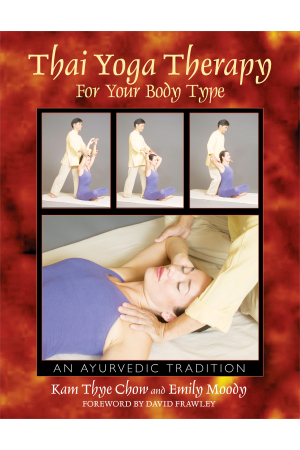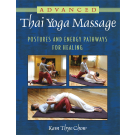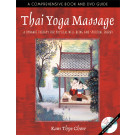Thai Yoga Therapy for Your Body Type
An Ayurvedic Tradition
- Pages: 240
- Book Size: 8.5 x 11
- ISBN-13: 9780892811847
- Imprint: Healing Arts Press
- On Sale Date: June 15, 2006
- Format: Paperback Book
- Illustrations: 152 b&w illustrations
• Explains how to determine a person’s Ayurvedic body type and provides hands-on techniques for working with them
• Brings the practices presented in Thai Yoga Massage to a new customized level of therapeutic healing
The traditional healing arts of Ayurveda and Thai Yoga Massage have a deep and integrated relationship that provides an unparalleled modality for restoring body, mind, and spirit. Although it originated in India, over the centuries Ayurveda has been assimilated into the predominant Thai culture and has evolved into a distinctive folk medicine. With the growing popularity of Ayurveda and Thai Yoga Massage, there is a renewed interest in reuniting these practices into a powerful therapeutic alliance.
Thai Yoga Therapy for Your Body Type bridges the practice of Thai Yoga Massage with its ancient Ayurvedic roots to offer a complete and holistic healing modality. The authors first explain in detail the fundamental principles of Ayurveda and then recommend daily practices for each of the three main body types of vata, pitta, and kapha. Practitioners learn how to customize their work with the appropriate massage approach, recommended yoga asanas, breathing techniques, and diet and lifestyle tips. More than 50 illustrated, full-body Thai Yoga Massage postures are presented as well as a massage flow for each body type. The authors indicate the Ayurvedic benefits of each posture and detail any precautions that should be followed in this dynamic practice of transformative healing.
from Chapter 3
Customizing a Massage According to Ayurvedic Principles
Once you have determined the main Ayurvedic dosha of a recipient, you are ready to design your Thai Yoga Massage according to the individual needs of each client. The first key to integrating Ayurveda into a Thai Yoga Massage practice are the main massage approaches that correspond to each doshic type.
According to Vedic philosophy, there are three forces of nature within the universe that are present within all matter and are responsible for all creation. These three subtle qualities, or gunas, are known as sattva, rajas, and tamas. Sattva is understood to be the most subtle of the three and is defined as harmony, light, and intelligence. Rajas, a vital force, relates to activity, movement, and excitability. Our present-day society, characterized by constant movement and activity, is ruled by rajas. The tamas guna, considered to be the most material of the three, is associated with heaviness, darkness, and inertia.
Within the practice of Ayurvedic bodywork, the three main massage techniques are defined in relationship to these forces of nature.
Sattvic Touch
The harmonizing quality of the sattvic approach is most suitable for vata types, who tend to be sensitive in nature and can be overwhelmed by too much stimulation. The sattvic massage approach is characterized by a light, gentle touch done at a slow and easy pace. Of the three approaches, this one involves the least amount of pressure; it is most suited to vata individuals, who tend to be more sensitive to pain and have more delicate bone structures. Although a long, gentle hold may be appropriate in some instances to ground vatas, it should never cause them excessive strain. It may be tempting to twist your thin, flexible vata client into a series of challenging postures, but this will actually do the person more harm than good. A slow, even pace with frequent repetitions is more appropriate.
The mild, harmonizing sattvic approach balances out vata’s tendency toward erratic energy flow, anxiety, and nervous disorders. A pleasant and nourishing environment can be created with the use of serene music, candles, and plush pillows and blankets. As vata individuals tend to chill easily, make sure that the massage room is at a warm, comfortable temperature.
The best time to massage a vata person is at dawn or dusk, when vata tends to be the highest and most prone to imbalance. It is possible to integrate the use of oil at the end of a massage by applying small amounts to the hands, feet, face, and specific marma points that can be easily accessed. Sesame oil is a favorite in all forms of Ayurvedic treatment and is especially good for vata types because of its warming, heavy, and pacifying qualities. Earthy aromas such as cinnamon, patchouli, or sandalwood can help to ground vata individuals.
Rajasic Touch
As the rajas guna is a force of activity, it follows that the rajasic approach to massage involves more energy and movement than the sattvic approach. This massage approach is most appropriate for pitta individuals, who require a moderately active massage to release built-up energy. While pitta types also need to be cooled and calmed, the slow and sedating sattvic approach will leave them feeling frustrated and wanting more. As a middle way, the rajasic touch uses firm pressure with a steady and flowing pace that calms and restores pitta individuals. Because pitta types may be easily aggravated by excessive heat, the use of force should be monitored and counterbalanced, incorporating a brief pause between the more stimulating postures. Avoid long holds in the postures, as this can be heating. The aim should be to work through tensions rather than to break up resistance. Steady, probing movements can be used to expel toxins, aid digestion, and alleviate muscular tension. During energy-line work, take care not to over-thumb or over-palm your pitta recipients, as these techniques increase circulation and have a heating effect on the body. Also, excessive rubbing may irritate sensitive pitta skin, which is prone to rashes and inflammation.
The best time for a pitta person to receive a massage is at high noon or midnight, when the sun’s effect is most powerful and needs to be relieved. If using oils for localized application, pitta types benefit from light or cooling oils such as sunflower, olive, or coconut. Sweet and calming floral scents such as rose and lavender, or the cooling scent of sandalwood, are also recommended.
Tamasic Touch
The tamas guna is characterized by heaviness and solidity. The tamasic massage approach involves the deepest and most rigorous touch techniques. This massage approach is suitable for kapha types, whose thick, oily skin requires the most stimulation.
Kapha individuals benefit from a strong and forceful bodywork approach that breaks up stagnation and accumulation. The pacing for this massage is the fastest of all three approaches and involves intensity and determination on the practitioner’s part. The aim is to circulate stagnant energy on the physical, mental, and emotional levels.
Kapha types may love to receive a soft and soothing massage, but such an approach would only plunge them into a deeper state of slumber. Of the three primary doshic types, kaphas can handle long holds with exertion--you can save your most dynamic Thai Yoga Massage moves for them! The use of well-paced repetitive movements, such as rotations and stretches, can help to open up the body and get things moving. The best time for massaging your kapha clients is in the late morning or late evening, when this force is strongest in the body.
Finally, because kapha types already tend to have oily skin and hair, it is best to avoid most oils or to apply small amounts of light oils, such as safflower or sunflower. Stimulating, energizing scents that open the nasal passages, such as eucalyptus or mint, benefit kapha individuals and can be applied to the chest and nose in cases of heavy congestion.
Acknowledgments
Foreword by Dr. David Frawley
PART 1: THE AYURVEDIC FOUNDATIONS OF THAI YOGA THERAPY
1. The Buddha’s Medicine Travels to Thailand
2. Ayurveda and the Five Elements of Life
3. Customizing a Massage According to Ayurvedic Principles
4. Energy Points and Pathways
PART 2: THE PHYSICAL ELEMENTS OF THAI YOGA MASSAGE
5. Thai Yoga Massage Stances and Touch Techniques
6. Working the Sen Lines and Marma Points
7. Thai Massage Pranayama
PART 3: THE THAI YOGA MASSAGE SERIES
8. Sitting Postures
9. Double- and Single-Foot Postures
10. Single-Leg Postures
11. Back Postures
12. Double-Leg Postures
13. Postures for the Abdomen, Chest, Arms, and Hands
14. Session Closure
PART 4: A THAI YOGA THERAPY WELLNESS PROGRAM
15. Yoga Approaches for the Three Doshas
16. Food and Vitality: Ayurvedic Nutrition
17. Ayurveda for Life
APPENDICES
Ayurvedic Consultation Form
Ayurvedic Constitutional Test
Wellness Therapy Program
Thai Yoga Therapy Sequence for Vatas
Thai Yoga Therapy Sequence for Pittas
Thai Yoga Therapy Sequence for Kaphas
Resources
Bonnie Cehovet, Angelfire, Aug 2006
Thai Yoga Therapy for Your Body Type presents a thorough and practical exploration of this healing practice. It is highly recommended for all consumer health information collections, particularly those with a focus on complementary and alternative medicine.
Susan Murray, Consumer Health Information Service, Toronto Reference Library, Toronto, Canada
HEALTH / BODYWORK
Thai Yoga Massage is a dynamic bodywork therapy in which the practitioner guides the recipient through a series of yoga postures while palming and thumbing along the body's energy lines and pressure points. Together these actions result in a treatment that relieves muscular tension, improves circulation, boosts the immune system, and balnaces the body energetically. This unique transformative healing system, which is growing in popularity in the Western world, originated in the temples of Thailand many centuries ago as a blend of yoga, Ayurveda, and martial arts.
In Thai Yoga Therapy for Your Body Type, Kam Thye Chow, one of the foremost practitioners of Thai Yoga Massage and the author of the book and DVD Thai Yoga Massage, and coauthor Emily Moody show how to tailor the practice to the individual needs of each recipient through the application of Ayurvedic principles. The three basic body types described by Ayurveda--vata, pitta, and kapha--each have different physical attributes and energetic needs that respond differently to each Thai Yoga Massage posture. Practitioners learn the Ayurvedic benefits of each posture as well as breathing techniques, diet and lifestyle tips, and the precautions that should be followed to adapt their massage approach to best meet the needs of their clients. More than 50 illustrated, full-body Thai Yoga Massage postures are presented as well as a complete massage flow for each body type.
KAM THYE CHOW, author of Thai Yoga Massage and Tai Chi Chuan: Mindfulness in Motion, is the founder and director of the Lotus Palm School in Montreal. EMILY MOODY is an Ayurvedic educator, yoga instructor, and teacher for the Lotus Palm School and has worked closely with Kam Thye since 1999.








